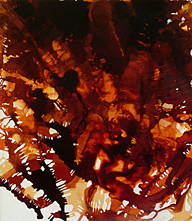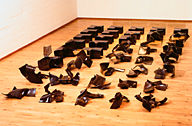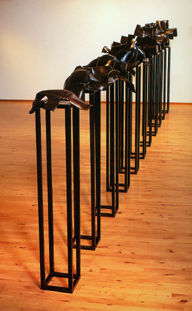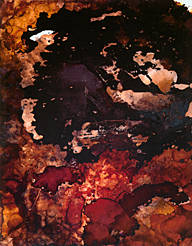

By Dominique Nahas
I propose the relevance and importance of Guðjón Bjarnason’s work lies not in the so-called ‘performative’ level of the objects that exist in front of our eyes, with their formal and stylistic significance, however competent, or even masterful they might appear, however ‘visually relevant’ to particular aesthetic partisan concerns they might be at the time of their viewing now or in the future. Rather his work materially embodies a meta-narrative of meaning that expresses a condition beyond meaning (le sens), allowing us to apprehend instead a direction (un sens). Bjarnason’s work, then, consists of a series of phenomenological visual inquiries that are primarily involved in traces rather than signposts, and those traces activate flows of meanings rather than the concept of meaning itself.
The primary motivation for Bjarnason’s art is to apply discursive and intuitive knowledge in order to raise questions about the origins of life and the generation of thought. His work consists in gathering together substances, and organising constituent matter, in order to systematically recapitulate what one might uncover through gaps that are so evident in his work. These gaps are of primary importance. Their meanings are defined by their limits and their boundaries. Bjarnason’s talent and his approach lies in this area: the gaps he explores are made bare by purposefully restricting the range of possibilities in his work, and by intermittently alternating between the control and the non-control of the ‘ready-made’ aspect of materials or objects he uses and by the forceful usage of contradictory impulses in his work that oscillate between the personal and the impersonal, Eros and Logos while refusing to make this dialectic the organising principle in his work.
Guðjón Bjarnason’s expansive work are traceries consisting of vast enigmas that attempts an impulse towards what Derrida has termed ‘a sliding movement towards a sovereign silence that attempts to articulate its trace of no trace - its movement away from symmetric relations - a bounding away from a syntax of oppositional forms’. The contradictions in the artist’s work arise out of purposeful ambiguity through which is drawn are drawn unexpected meanings and associational levels.
Stylistically Guðjón Bjarnason works primarily through a reductivist conceit which organises his sculptural and painterly material in hierarchically ordained patterns along with a sign system of semiotic play and which continually suggests the interplay between abstraction and representation, between geometric ordering within expressionistic impulses, how one set of codes encourages and nourishes the seminal aspects of another set of codes. The artist thus systematises (or at least gives the impression of such) his very private responses to what appear to be large, if not bold, public works. It is this conflation of his genuinely felt musings on the structure of reality and what might be called an intemperate and fearless self-interrogation which attempts to emplace his cogitatio, embedding the world within it. This self-reflexivity is embodied in the artist’s use of materials and it is quite apparent that Bjarnason has a closeness, an affinity not only with materials but with the struggle to shirk off the implacability of his material substances whether they be steel, bronze, oil on canvas, or mixed media on paper.
Primarily, Guðjón Bjarnason’s search through the use of his materials exemplifies a far-reaching inquiry on the aspect of the imaginary as it allows both entry and egress into the void which constitutes the impossible, the birthplace of the unknowable as Bataille would have it, where the sacred is manifest. Bjarnason’s work, particularly in his dynamited structures deals with both a level of inquiry that concerns itself with making clear the tension that exists between what Wilhelm Reich remarked is the inherently fascistic nature of the mind of everyday man in that it seeks order and imposes control over its environment at all costs in order to avoid surprises, and between a non-judgmental open-endedness, a positive ambiguity, through which the ‘tight interlacing of the symbolic with the imaginary’ (as Maurice Blanchot expresses it in La Question de l’Ecriture) can see the light of day.
The tension is further enlivened by the artist’s evident desire to hold in balance a suggestion of transcendence through which the imagining self can express itself symbolically. Yet Bjarnason’s work makes it equally clear that this desire can only be made manifest through the facticity of his materials. As Sartre says in L’Imaginaire: ‘In order to imagine it is necessary that consciousness have the capacity to go beyond the real while constituting it as the world since the negation of the real is always implied through its constitution as the world.’
Thus in Bjarnason’s work we see it recording the traces of its own history in an attempt to elude closure or a regress into the void. His art arises out of resistance, resisting even its organisational principle of separateness in order to offer access to an experience of impossibility that raises it from the level of not-knowing into that of the unknowable. Blanchot recalls in The Infinite Conversation that ‘what reigns in the experience of impossibility is not the unique’s immobile collecting into itself, but the infinite shifting of dispersal, a non-dialectical movement where contrariety has nothing to do with opposition or reconciliation, and where the other never comes back to the same. Shall we call it becoming, the secret of becoming? A secret apart from every other secret and that gives itself as the diverging of difference.’ That freedom of dispersal is experienced as physical gaps seen through the ruptures and eruptions in Bjarnason’s art.
It is clear that his enigmatic artworks have the capacity to enfold a range of possibilities: reference to sublimity, for example, is suggested through the Platonic ordering of his reductivist structures while simultaneously allowing a quality of brute raw energy and its dissipation to co-exist with this notion of the sublime transcendence. That energy, both actively destructive (seen in the artist’s dynamited works such as Logical Disappearance, 1997 which incorporates the sign of the blasted cruciform) and in latently constructive works (as in canvases such as Paradoxical Stasis 1997), permits itself the primary role of exploring an aspect of reality that is not to be codified through logical or alogical procedures, that are beyond the visual datum that signify the dilapidation or the refructifying of forms, away from the effects of metaphoric transgression and taboo as seen through the act of the violation of the prima materia through its covert dispersal, and even further away from the act of re-invigorating the flow of congealed energies through a recalling of seminal traces through the sign of the multiplied phallus.
It is of fundamental importance to understand that there is a disavowal in all of Bjarnason’s art of any a priori systematisation of what might constitute a creative (or un-creative) act. And it is this very disavowal, this refusal that engenders the ideational gaps in the artist’s works, the gaps that are the life source of the vitality in his work. This disavowal carries within it a re-routing of dialectical polarities (thus subordinating the works’ tracing of libidinal flows into programmatic contrarieties such as heroism/anti-heroism, natural/cultural, mind/body) without necessarily divesting himself from such applications when necessary. In Writing and Difference Derrida states ‘It is a question of explicitly and systematically posing the problem of the status of a discourse which borrows from a heritage the resources necessary for the deconstruction of that heritage itself. A problem of economy and strategy.’ Such economy and strategy is seen throughout the artist’s work through his intermittent re-routing and overlapping of various aesthetic procedures that include aspects of collage, modelling and carving. This intermittent re-routing of intentionalities allows the aleatory to interfere as well as to direct the current of his flows of inquiries in regards to matter, material forms, or anti-forms along with the rational but it allows them both a voice at different rates and times throughout the fabrication of each artwork.
One of the keys to the understanding of Guðjón Bjarnason’s work (and let us consider this suggestion at the end of this text merely as a point of departure), is to see it in the process of dismantling and dispersing the traditional armour of expected intentionalities that surround art-making at the end of this century and then using the residues of those former shadow presences to re-invigorate inquiries about the nature of its own procedures. The result are charged objects of contemplation that raise (in Blanchot’s words) ‘the most profound question [which] is this experience of being diverted in the mode of a questioning that is foreign, anterior, or posterior to any question. Man is turned by the profound question toward what turns aside - and turns itself aside’.
Dominique Nahas is a Manhattan-based independent curator and critic. He is the former Chief Curator of Contemporary Art, Everson Museum, Syracuse, and the former Director, Neuberger Museum, SUNY-Purchase, NY. Among his projects he has organised and curated the American retrospectives of the artists Les Levine and Nancy Spero. A regular contributor to REVIEW magazine, his articles have been published in publications such as Sculpture, C, Trans, and New Observations. He is presently organising a survey exhibition of the work of Osvaldo Romberg for the Kunstmuseum Bonn. This text was printed in the catalogue for Guðjón Bjarnason’s exhibition in the Nordic House in Reykjavík in the summber of 1997, entitled Large Works.
text © Dominique Nahas
artwork © Gudjón Bjarnason
Oil on canvas, 233 x 202.5 cm

Oil on canvas, 233 x 204 cm

Exploded steel, oil and varnish, 20 x 190 x 333 cm

Exploded steel, oil and varnish,
aprox. 166 x 45 x 700 cm
to understand that there is a disavowal in all of Bjarnason’s art of any a priori systematisation of what might constitute a creative (or un-creative) act.

Oil varnish on paper, 51 x 41 cm
|
|
|
|
|
|
|
|